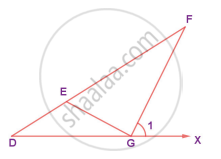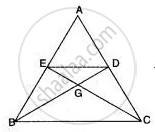Advertisements
Advertisements
प्रश्न
In the figure, if ∠FEG ≡ ∠1 then, prove that DG2 = DE.DF
उत्तर
Proof:
| S.No. | Statements | Reasons |
| 1. |
∠FEG ≡ ∠1 ⇒ ∠DEG = 180° − ∠FE |
Given linear pair |
| 2. |
∠FDG + ∠DGF = 1 ∠EDG + ∠DFG = 1 |
Exterior angle = Sum of interior opposite angles ∵ ∠FDG = ∠EDG |
| 3. |
∠DEG = 180° − ∠FEG ∠DEG = 180° − ∠1 |
By 1 |
| 4. |
In ΔDFG ∠DEG = 180° − [∠FDG + ∠DFG] |
Angle sum property |
| 5. | ∠DGF = 180° − ∠1 | By 2 |
| 6. |
∠DGF = ∠DEG |
By 3 |
| 7. |
∠EDG = ∠EDG |
Common in ΔFDG and ΔEDG |
| 8. | ∴ ∠DGE = ∠DFG | Remaining angle by sum property and by 6 |
| 9. | ∴ ΔDGF ∼ ΔDEG |
By 6, 7, 8 By AAA similarity |
| 10. | `"DG"/"DE" = "GF"/"EG" = "DF"/"DG"` | Corresponding sides of similar traingle are proportional |
| 11. |
`"DG"/"DE" = "DF"/"DG"` DG.DG = DF.DE DG2 = DE.DF |
From 9 |
APPEARS IN
संबंधित प्रश्न
`triangleDEF ~ triangleMNK`. If DE = 5 and MN = 6, then find the value of `(A(triangleDEF))/(A(triangleMNK))`
In the given figure, DE║BC and DE: BC = 3:5. Calculate the ratio of the areas of ΔADE and the trapezium BCED.

Δ ABC is similar to Δ PQR. If AB = 6cm, BC = 9cm, PQ = 9cm and PR = 10.5cm, find the lengths of AC and QR.
In the adjoining figure, the medians BD and CE of a ∆ABC meet at G. Prove that
(i) ∆EGD ∼ ∆CGB and
(ii) BG = 2GD for (i) above.
In the given figure ABC and CEF are two triangles where BA is parallel to CE and AF: AC = 5: 8.
(i) Prove that ΔADF ∼ ΔCEF
(ii) Find AD if CE = 6 cm
(iii) If DF is parallel to BC find area of ΔADF: area of ΔABC.
In ΔABC, point D divides AB in the ratio 5:7, Find: `"AE"/"AC"`
ΔABC is enlarged, with a scale factor 5. Find: A'B', if AB = 4cm
If in triangles ABC and EDF, `"AB"/"DE" = "BC"/"FD"` then they will be similar, when
D is the mid point of side BC and AE ⊥ BC. If BC = a, AC = b, AB = c, ED = x, AD = p and AE = h, prove that b2 + c2 = `2"p"^2 + "a"^2/2`
In ΔPQR, S and T are points on PQ and PR respectively. `(PS)/(SQ) = (PT)/(TR)` and ∠PST = ∠PRQ. Prove that PQR is an isosceles triangle.
